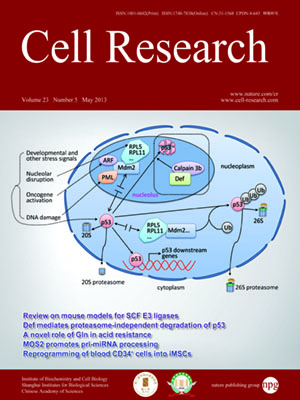
Volume 23, No 5, May 2013
ISSN: 1001-0602
EISSN: 1748-7838 2018
impact factor 17.848*
(Clarivate Analytics, 2019)
Volume 23 Issue 5, May 2013: 673-690
ORIGINAL ARTICLES
FNβ/TNFα synergism induces a non-canonical STAT2/IRF9-dependent pathway triggering a novel DUOX2 NADPH Oxidase-mediated airway antiviral response
Karin Fink1,2, Lydie Martin1,*, Esperance Mukawera1,*, Stéfany Chartier1, Xavier De Deken3, Emmanuelle Brochiero1,4, Françoise Miot3 and Nathalie Grandvaux1,2
1Centre de Recherche du CHUM (CRCHUM), Montréal, Québec, Canada H2X 1P1
2Department of Biochemistry, Faculty of Medicine, Université de Montréal, Québec, Canada H3T 1J4
3Institut de Recherche Interdisciplinaire en Biologie Humaine et Moléculaire, Université Libre de Bruxelles, Campus Erasme, 1070 Brussels, Belgium
4Department of Medicine, Faculty of Medicine, Université de Montréal, Montréal, Québec, Canada H3T 1J4
Correspondence: Nathalie Grandvaux,(nathalie.grandvaux@umontreal.ca)
Airway epithelial cells are key initial innate immune responders in the fight against respiratory viruses, primarily via the secretion of antiviral and proinflammatory cytokines that act in an autocrine/paracrine fashion to trigger the establishment of an antiviral state. It is currently thought that the early antiviral state in airway epithelial cells primarily relies on IFNβ secretion and the subsequent activation of the interferon-stimulated gene factor 3 (ISGF3) transcription factor complex, composed of STAT1, STAT2 and IRF9, which regulates the expression of a panoply of interferon-stimulated genes encoding proteins with antiviral activities. However, the specific pathways engaged by the synergistic action of different cytokines during viral infections, and the resulting physiological outcomes are still ill-defined. Here, we unveil a novel delayed antiviral response in the airways, which is initiated by the synergistic autocrine/paracrine action of IFNβ and TNFα, and signals through a non-canonical STAT2- and IRF9-dependent, but STAT1-independent cascade. This pathway ultimately leads to the late induction of the DUOX2 NADPH oxidase expression. Importantly, our study uncovers that the development of the antiviral state relies on DUOX2-dependent H2O2 production. Key antiviral pathways are often targeted by evasion strategies evolved by various pathogenic viruses. In this regard, the importance of the novel DUOX2-dependent antiviral pathway is further underlined by the observation that the human respiratory syncytial virus is able to subvert DUOX2 induction.
Cell Research (2013) 23:673–690. doi:10.1038/cr.2013.47; published online 2 April 2013
FULL TEXT | PDF
Browse 2105


